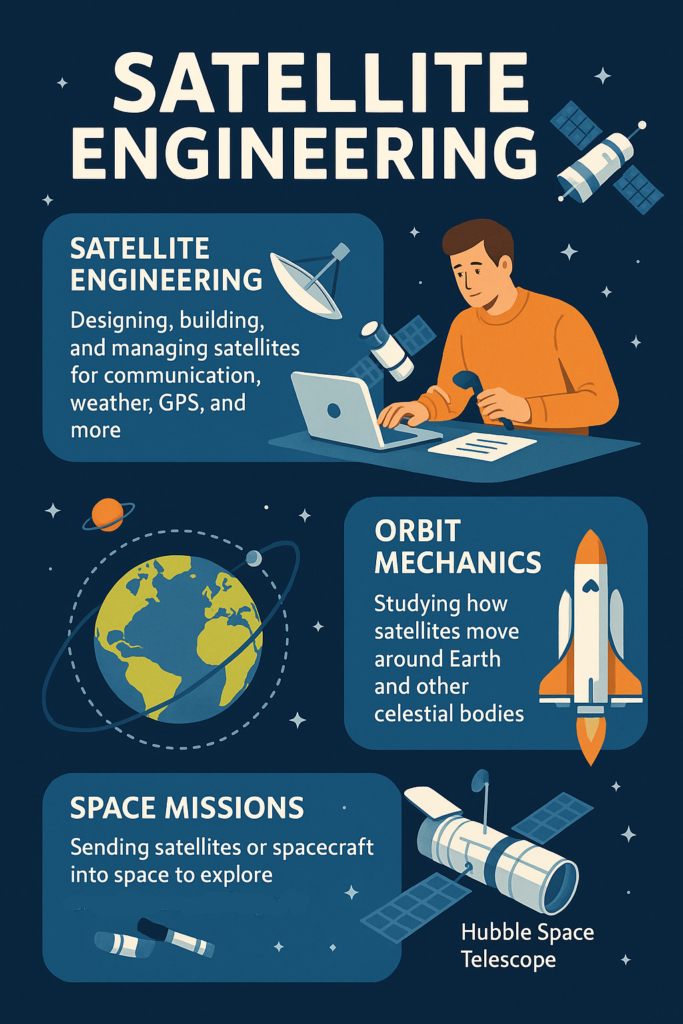Satellite Engineering is all about designing, building, and managing satellites—those machines that orbit Earth or even other planets to help with things like communication, weather forecasting, GPS, and space exploration.

Orbit Mechanics (How Satellites Stay in Space)
What is it?
Orbit mechanics, also called orbital mechanics, is the study of how satellites move around Earth or other celestial bodies. Imagine throwing a ball in the air—if you throw it hard enough, it keeps going without falling back down. Satellites do something similar but with the help of gravity.
Key Concepts:
- Gravity: It pulls satellites toward Earth, but they’re moving so fast sideways that they keep missing Earth. This creates a stable orbit.
- Orbits: There are different types:
- Low Earth Orbit (LEO): Close to Earth, good for satellites like the ISS (International Space Station).
- Medium Earth Orbit (MEO): Used for GPS satellites.
- Geostationary Orbit (GEO): Stays above the same spot on Earth—perfect for communication satellites.
How it Works:
Satellites need the right speed and altitude to stay in orbit. Too fast, and they’ll fly away; too slow, and they’ll fall back to Earth.
2. Satellite Communication (How Satellites Send Signals)
What is it?
Satellite communication is the technology that allows satellites to send and receive information—like TV signals, internet data, phone calls, and weather updates.
How It Works:
- Transponders: These are like satellite “repeaters.” They receive signals from Earth, amplify them, and send them back to Earth.
- Frequency Bands: Satellites use different frequencies (like radio channels) to communicate, such as L-band, C-band, Ku-band, and Ka-band.
- Ground Stations: These are the antennas on Earth that send signals to the satellite and receive signals back.
Example:
When you watch satellite TV, the signal travels from your dish to the satellite in space, gets bounced back down to Earth, and reaches your TV.
3. Space Missions (Exploring Beyond Earth)
What is it?
Space missions involve sending satellites or spacecraft into space to explore, gather data, or achieve specific goals. These missions can be for scientific research, weather monitoring, military purposes, or even space exploration.
Types of Space Missions:
- Earth Observation Missions: Monitor weather, climate, agriculture, and natural disasters.
- Communication Missions: Provide global internet, TV broadcasts, and military communication.
- Navigation Missions: Like GPS satellites, helping with location services on Earth.
- Deep Space Missions: Send probes to explore other planets, moons, or even asteroids.
Example:
The Hubble Space Telescope is a space mission designed to capture breathtaking images of distant galaxies, helping scientists learn more about the universe.
How Satellites Are Designed:
- Planning: Decide the satellite’s purpose (communication, navigation, weather, etc.).
- Design: Choose the right orbit, size, power source (like solar panels), and communication systems.
- Testing: Make sure it can survive harsh space conditions—extreme temperatures, radiation, and vibrations.
- Launch: Use rockets to send the satellite into space.
- Operation: Monitor and control the satellite from ground stations.
Tags: C-band, communication satellites, deep space missions, Earth observation, frequency bands, Geostationary Orbit (GEO), GPS, gravity, ground control, ground stations, Hubble Space Telescope, Ka-band, Ku-band, L-band, Low Earth Orbit (LEO), Medium Earth Orbit (MEO), mission planning, navigation satellites, orbit mechanics, orbital mechanics, rocket launch, satellite altitude, satellite building, Satellite communication, satellite design, Satellite Engineering, satellite launch, satellite management, satellite operation, satellite orbit selection, satellite purpose, satellite speed, satellite testing, satellite TV, signal transmission, solar panels, space environment, Space exploration, space missions, space probes., stable orbit, transponders, weather monitoring


